What makes a hero turn evil? What path sends a person who was willing to fight the good fight, turn to the darkness? It doesn’t usually happen overnight. It’s a slow burn — unless you’re possessed, which happens quite often in the world of comics, as you’ll see.
The real measure of a comic book hero’s villainy is whether or not their publisher allows them to stay evil. Far too often, a story is told in which the hero or heroine is seduced to the dark side, only to be forgiven for everything a short while later. Hitting that reset button takes the bite out of every evil action, and completely defangs all of the drama that having a good guy go bad is meant to generate.
The following 16 superheroes became full-fledged supervillains, but less than half of them stayed evil.
16. DAREDEVIL
 Daredevil has always been a hero who leans a little closer to the harsh end of the vigilante spectrum. So seeing him become a villain after starting down a darker path than usual was, in a way, a logical conclusion. But in the end, it turned out to be just the latest case of “possessed by an evil entity.” You’ll see several more of these as we go along.
Daredevil has always been a hero who leans a little closer to the harsh end of the vigilante spectrum. So seeing him become a villain after starting down a darker path than usual was, in a way, a logical conclusion. But in the end, it turned out to be just the latest case of “possessed by an evil entity.” You’ll see several more of these as we go along.
During a trip to Japan, Daredevil won control of the Hand ninja clan, and returned to New York with his lethal new minions in tow. His first order of business was to erect a spanking new headquarters in the middle of Hell’s Kitchen that he dubbed Shadowland, which also functioned as a prison for anyone he deemed a threat. His methods of apprehending the guilty grew harsh, he ran afoul of other superheroes, and he even killed his longtime adversary, Bullseye.
Eventually the heroes figured out that Daredevil was possessed by a demon called the Beast of the Hand. In the end he was exorcised by Iron Fist’s chi powers, and then he killed himself to keep the demon from repossessing him (after which Elektra brought him right back to life of course). He cut out of town for a while, understandably, but it wasn’t long before things reverted to normal.
15. BUCKY BARNES
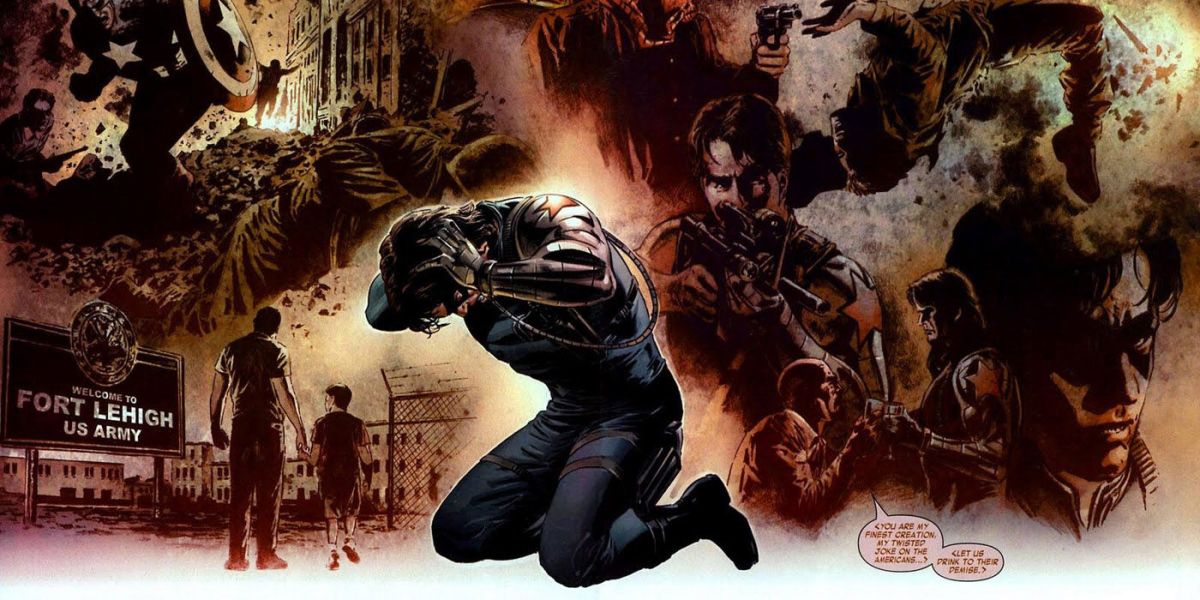 Poor Bucky. Once Captain America’s best friend and loyal sidekick, his death during World War II served as a touchstone for Cap’s future motivations for decades. So it came as a great shock when Bucky was discovered alive in the here-and-now and functioning as a covert secret operative known as the Winter Soldier.
Poor Bucky. Once Captain America’s best friend and loyal sidekick, his death during World War II served as a touchstone for Cap’s future motivations for decades. So it came as a great shock when Bucky was discovered alive in the here-and-now and functioning as a covert secret operative known as the Winter Soldier.
Hydra wiped his mind, gave him a new metal arm to replace the one he’d lost in the war, and kept him in suspended animation between missions, allowing him to age to roughly the same amount as the modern Steve Rogers. As the Winter Soldier, Bucky undertook dozens of black ops missions for Hydra, his conditioning enforcing his loyalty and willingness to kill. Hydra also gave him a major skill boost.
It took the power of a Cosmic Cube for Captain America to finally restore his friend’s memories and true personality. He’s not the same Bucky he once was, though, as Hydra’s influence has left him hardened and more willing to “do what has to be done” for the greater good. After a stint serving as Captain America while Steve Rogers was believed dead, he reverted to his Winter Soldier persona. But now he’s one of the good guys.
14. MARY MARVEL
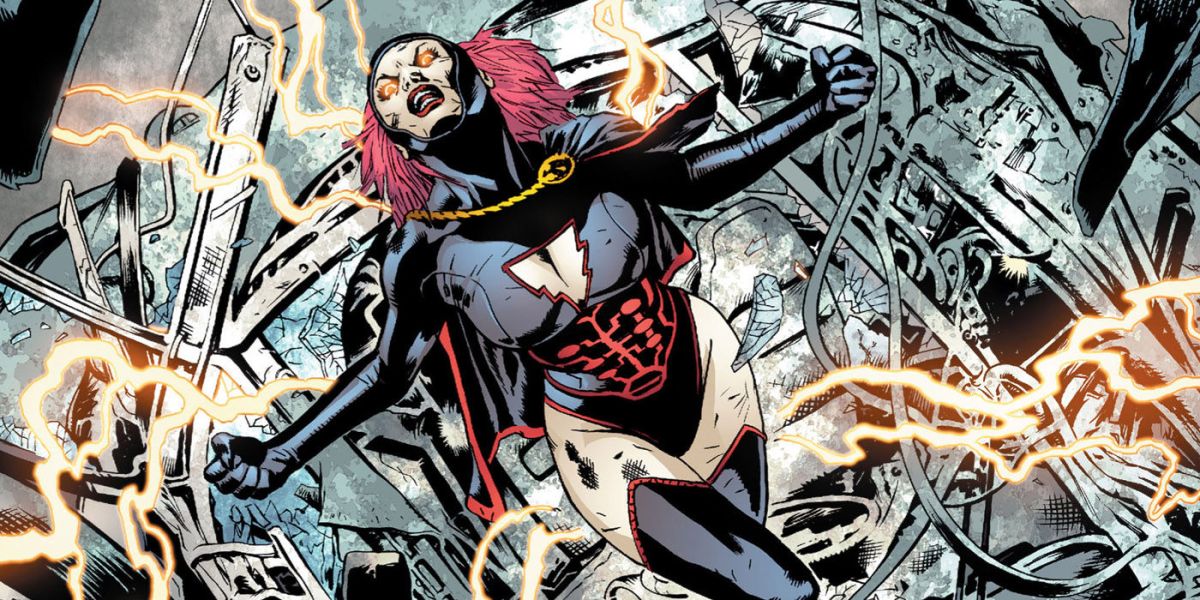 Mary Marvel may be the quintessential “good girl gone bad.” A member of Fawcett Comics’ Marvel Family, she has the same powers as Billy Batson (Shazam, formerly known as Captain Marvel) and is one of the earliest examples of spinning off a female hero based on a male character. (There are dozens of these today — Supergirl, Batgirl, Spider-Woman, She-Hulk, X-23, etc.) She made the move to DC with Captain Marvel and Captain Marvel Jr. when DC licensed the characters in the ’70s.
Mary Marvel may be the quintessential “good girl gone bad.” A member of Fawcett Comics’ Marvel Family, she has the same powers as Billy Batson (Shazam, formerly known as Captain Marvel) and is one of the earliest examples of spinning off a female hero based on a male character. (There are dozens of these today — Supergirl, Batgirl, Spider-Woman, She-Hulk, X-23, etc.) She made the move to DC with Captain Marvel and Captain Marvel Jr. when DC licensed the characters in the ’70s.
In 2006, DC sent Mary down a much darker path than readers ever expected. Mary lost her powers, fell into a coma, and later acquired new powers from the longtime nemesis of the Marvel family, Black Adam. Her exposure to Adam’s form of magic changed her, a turn of events exacerbated by her repeated manipulation from the likes of Darkseid, Granny Goodness, Eclipso, and Desaad, who (you guessed it) possessed her at one point.
She eventually reverted to her normal self — just in time for the New 52 reboot, which wiped away her entire history of evil. How convenient.
13. ANGEL/ARCHANGEL
 Warren Worthington III was one of the original five X-Men, but when he joined X-Force, things changed pretty drastically for him. As a child he’d begun growing feathery bird wings, and soon he was able to fly. As a mutant, he was an effective fighter and member of Charles Xavier’s initial team.
Warren Worthington III was one of the original five X-Men, but when he joined X-Force, things changed pretty drastically for him. As a child he’d begun growing feathery bird wings, and soon he was able to fly. As a mutant, he was an effective fighter and member of Charles Xavier’s initial team.
It was during a crossover event called “Mutant Massacre” that Warren’s wings were mutilated by an evil mutant named Harpoon. Each wing was impaled, crucifixion style, and they later became infected and had to be amputated. Warren was devastated by this turn of events, and at his weakest moment, the hyper-powerful villain Apocalypse offered to restore his wings if Angel would serve as Death, one of his Four Horsemen. He agreed. Warren’s superior fighting skills caused Apocalypse to name Warren, now the power-enhanced “Archangel,” as the lead Horseman.
Knowing their tactics and weaknesses, Archangel bested all of the X-Men in battle quite easily, but his buddy Iceman helped him recover his former self. Yet Apocalypse’s genetic alterations made changes that were too deep to allow him to ever go back to the innocent young man he was before. He continued to battle his inner darkness for years, and more recently he discovered the ability to transform between Angel and Archangel at will, in order to wield the powers of each.
Other X-Men have signed on with Apocalypse over the years, such as Gambit and Colossus. But Angel was the first.
12. SINESTRO
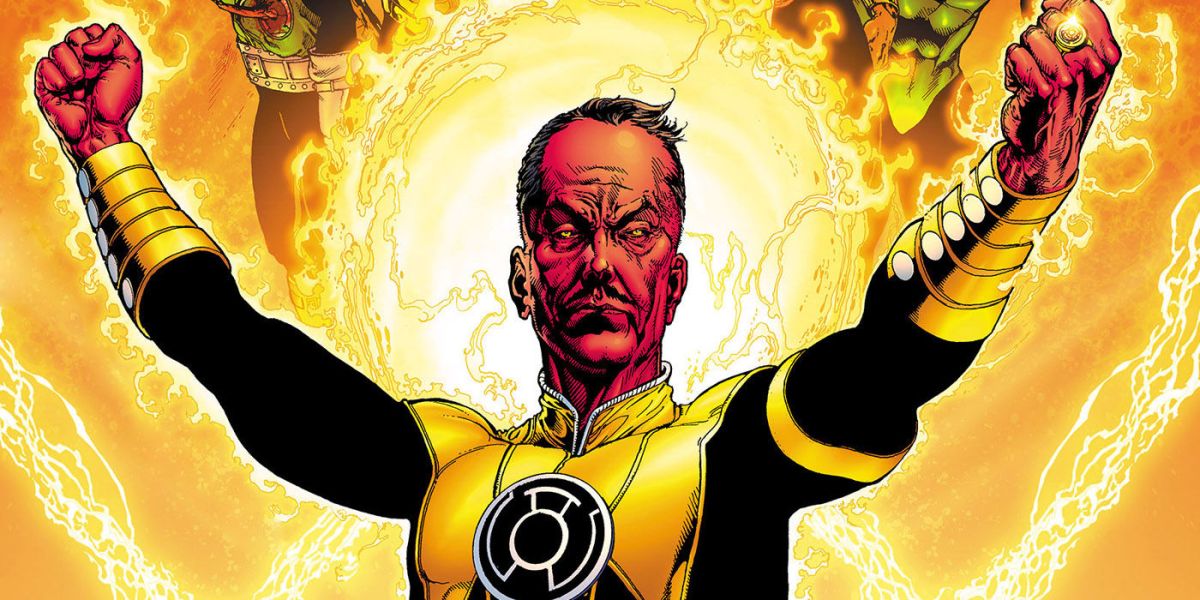 Long before Hal Jordan fell victim to Parallax and turned into a universe-threatening über-villain, another member of the Green Lantern Corps took the journey from good to bad: Sinestro, the Green Lantern who trained Hal Jordan. Jordan’s mentor was once considered among of the greatest of Lanterns, but his was a classic case of power’s corruption.
Long before Hal Jordan fell victim to Parallax and turned into a universe-threatening über-villain, another member of the Green Lantern Corps took the journey from good to bad: Sinestro, the Green Lantern who trained Hal Jordan. Jordan’s mentor was once considered among of the greatest of Lanterns, but his was a classic case of power’s corruption.
A native of the planet Korugar, Sinestro’s desire to protect his world and keep the peace turned into an enforced dictatorship of absolute order, thanks to abuse of his Lantern powers. When the Guardians on Oa found out, he was stripped of his ring and sent to the antimatter universe. There, he took up with the people of Qward, who made him a yellow ring based on the power of fear, and helped him seek revenge. He’s been Jordan’s arch-nemesis ever since.
Eventually, Sinestro launched his own ring-powered Corps, which counted Parallax, the Anti-Monitor, Cyborg Superman, and Superboy Prime among its members. Other colors popped up in the emotional spectrum, leading to the “Blackest Night” war. The Green Lantern titles more or less ignored the New 52 reboot, making only minimal changes, so Sinestro remains one of the few heroes-gone-bad who’s never returned to the light.
11. ULTIMATE REED RICHARDS
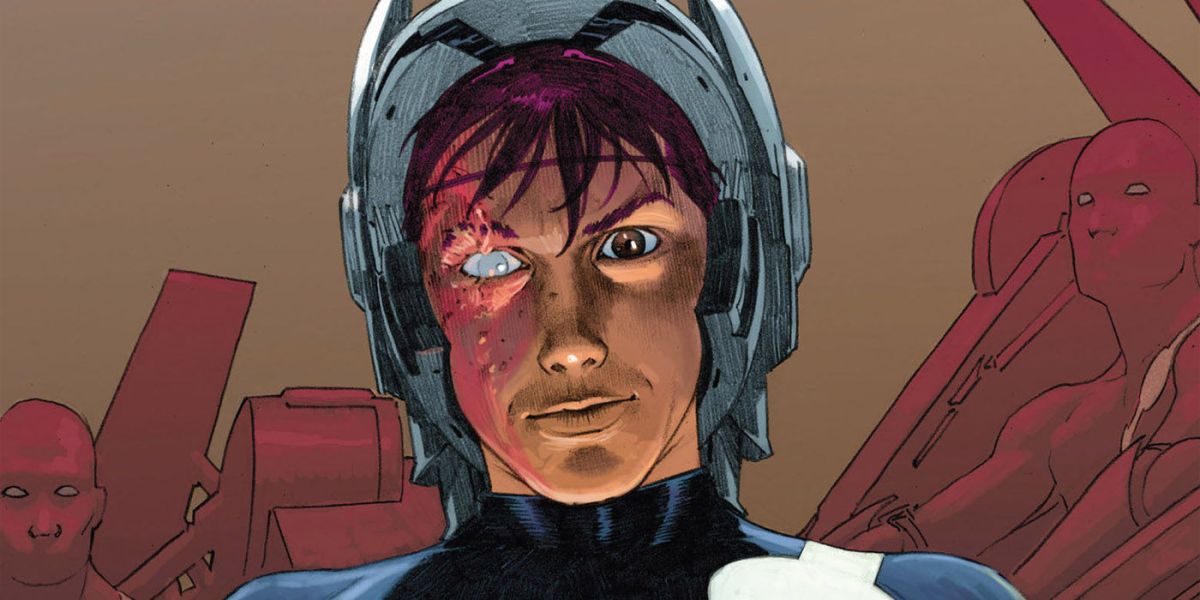 Not much survived the demise of Marvel’s “Ultimage Comics” universe, when the multiverse collapsed and was reborn thanks to the events of Secret Wars. Miles Morales was the big one, but a few other things have trickled in. The hammer Mjolnir that was wielded by Ultimate Thor made it over to Marvel’s main “616” universe, for example.
Not much survived the demise of Marvel’s “Ultimage Comics” universe, when the multiverse collapsed and was reborn thanks to the events of Secret Wars. Miles Morales was the big one, but a few other things have trickled in. The hammer Mjolnir that was wielded by Ultimate Thor made it over to Marvel’s main “616” universe, for example.
A villain named The Maker joined the 616 too, but comics fans who didn’t keep up with happenings in the Ultimate universe may not know who he is. This young genius has a wicked scar on his face and an even more wicked superiority complex. So who is he?
He’s the Ultimate universe’s version of Reed Richards, aka Mister Fantastic of the Fantastic Four. He started out well in a comic book that reinvented the FF as a team of four young adults involved at a government think tank (Josh Trank’s failed cinematic reboot was heavily based on Ultimate Fantastic Four). Reed was the best and brightest of that group, and an accident in the Negative Zone gave his team their powers.
Things were nice and heroic for a while, but after the world nearly ended in Ultimatum, the team disbanded, Reed proposed to Sue and she said no, and his childhood home was bombed while he was there. The experience not only scarred him physically, it drove him insane. He changed his moniker to “the Maker” and put his gifted intellect to use for some really nasty purposes.
It doesn’t seem as though Marvel has plans to redeem this version of Reed anytime soon.
10. AZRAEL
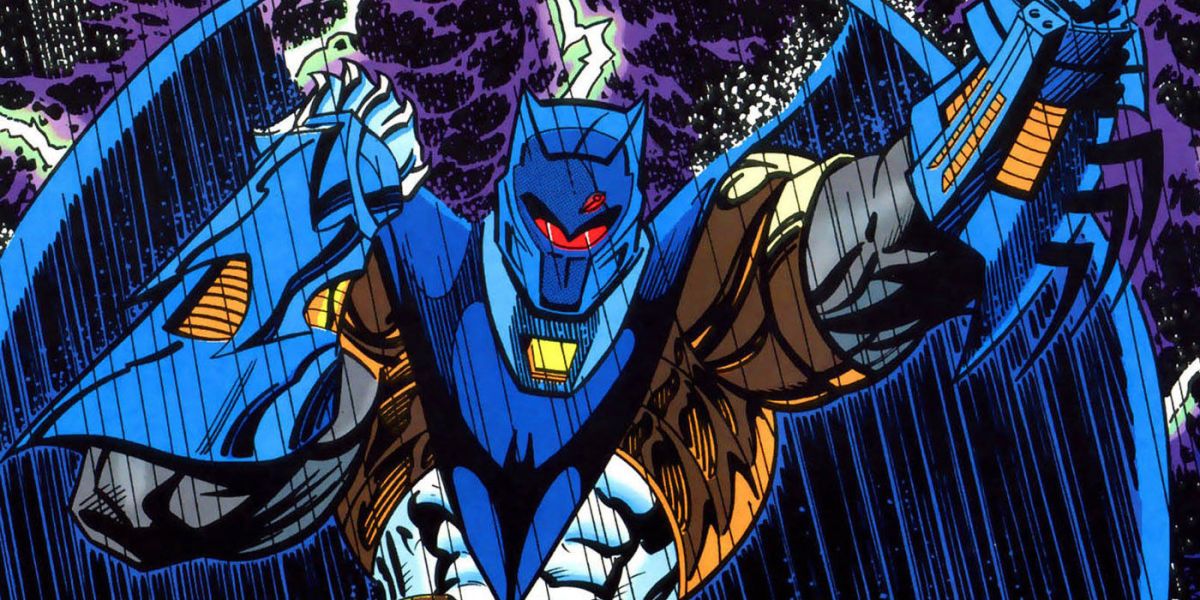 You know the story: Bane comes to town. Bane fights Batman. Bane breaks Batman’s back. Nope, not talking about The Dark Knight Rises, although that movie was partly inspired by this source material. It’s the plot of “Knightfall,” the 1993 arc that found the Dark Knight in sudden need of a successor.
You know the story: Bane comes to town. Bane fights Batman. Bane breaks Batman’s back. Nope, not talking about The Dark Knight Rises, although that movie was partly inspired by this source material. It’s the plot of “Knightfall,” the 1993 arc that found the Dark Knight in sudden need of a successor.
Rather than going with the obvious choice — Dick Grayson, now working as a solo hero, aka Nightwing — Bruce Wayne instead made an unorthodox choice. In reality, DC Comics was looking to shake up the status quo by putting someone new under Batman’s cowl for a while. Thus was born Jean-Paul Valley, or Azrael, as he’s now known. It was a case of villain becomes hero becomes villain again becomes hero again.
Valley was a brutal vigilante working for the Order of St. Dumas, whose purpose was to punish the guilty instead of protect the innocent. He met Batman, learned the error of his ways, started training with the Bat, yadda yadda yadda, and after the altercation with Bane, Bruce decided to name Valley his successor. Valley took on a preposterous costume that could not be any more ’90s, and became Batman.
It didn’t go well. Due to the conditioning he’d received all his life, he became unhinged, employing ever more barbaric tactics and suffering from hallucinations. Bruce Wayne’s recovery allowed him to stop the madness, breaking through Valley’s conditioning, and becoming Batman again. Valley, meanwhile, got better, took on the mythic role of Azrael, and worked with Team Batman for years before dying in the “No Man’s Land” crossover event.
9. PLUTONIAN
 Mark Waid’s Irredeemable was the superhero equivalent of Breaking Bad: the story of good man who turned evil. In this case, the man was Dan Hartigan, a superhero similar in power to Superman going by the name “Plutonian.” Unlike Superman, he came from a series of broken foster homes. As an adult, he confided his secret identity to his girlfriend, but she didn’t react anything like Lois Lane. She was outraged that he’d tricked her and told the whole world who he really was in retaliation.
Mark Waid’s Irredeemable was the superhero equivalent of Breaking Bad: the story of good man who turned evil. In this case, the man was Dan Hartigan, a superhero similar in power to Superman going by the name “Plutonian.” Unlike Superman, he came from a series of broken foster homes. As an adult, he confided his secret identity to his girlfriend, but she didn’t react anything like Lois Lane. She was outraged that he’d tricked her and told the whole world who he really was in retaliation.
Things went downhill from there. Dan had an affair with one of his fellow superheroes — who also happened to be a married woman. Later, he was partially responsible for an accident involving an alien virus that killed hundreds of children. He compounded the problem by trying to keep his part of the tragedy a secret, which his sidekick soon discovered. Plutonian snapped when confronted with the truth, and lobotomized his protege. Ouch. He then destroyed Sky City, his version of Metropolis and home to some 3.5 million people.
Most of this wasn’t revealed until late in Irredeemable‘s run, with the bulk of its issues dedicated to his former friends and allies both attempting to stop his mania and trying to find out why he turned evil. True to the book’s name, he never seeks or finds redemption on his own — but is redeemed in the end by the actions of another superhero who finds a way to force Plutonian to save the world.
The best part: we could be seeing this comic on the big screen in the very near future.
8. IRON MAN
 Okay, take a deep breath. We’ll try to simplify this as much as possible. If you read Marvel Comics, you’ve probably heard of Kang the Conqueror, a supervillain who’s fought the Avengers countless times. Kang is a time traveller, and has crossed his own timeline so many times, even the Doctor would give up ever trying to understand it.
Okay, take a deep breath. We’ll try to simplify this as much as possible. If you read Marvel Comics, you’ve probably heard of Kang the Conqueror, a supervillain who’s fought the Avengers countless times. Kang is a time traveller, and has crossed his own timeline so many times, even the Doctor would give up ever trying to understand it.
One future version of Kang is known as Immortus, and during a story arc called “The Crossing,” Immortus discovered a weakness in the neural link between Tony Stark and his Iron Man armor. The big bad exploited this link and began manipulating Tony’s psyche, having the Avenger do his evil bidding. It was subtle at first, but as the plot thickened, Tony eventually murdered three Avengers allies and would have killed more if his teammates hadn’t found a way to snap him out of it.
This is the story that famously brought in a teenage Tony Stark from another timeline to help stop his future self, and eventually replace him. The elder Tony commits suicide to stop Immortus, but Teen-Tony’s tenure is short-lived thanks to the coming of Onslaught. But Marvel’s ultimate deus ex machina, Franklin Richards, would later merge a reborn Tony Stark with his alternate teenage version. (Told you it was complicated.)
Anyhoo, Onslaught led into the “Heroes Reborn” initiative, which didn’t work out so great. About a year later, Heroes Reborn was dead and everything reverted to the way it was before. Tony Stark was Iron Man again and was absolved of his pre-Onslaught actions.
A more recent event called Axis caused Tony to become the greedy, opportunist entrepreneur seen in Superior Iron Man, but he got over it.
7. CYCLOPS
 Once upon a time there was a nice X-Man named Scott Summers. He was reliable, responsible, and level-headed. And then, in a long series of attempts to make him more interesting by giving him shades of gray, Marvel assassinated his character. Cyclops’ troubles began in the mid-’80s, after he’d mourned the loss of Jean Grey (thanks to the Phoenix Saga) and married a woman named Madelyne Prior. They had a son named Nate, who would grow up via time travel to become Cable. When Scott learned that Jean was still alive after all — thanks to some heavy-handed editorial retconning — he made the jerk move of running out on his family and returning to his first love. Strike one.
Once upon a time there was a nice X-Man named Scott Summers. He was reliable, responsible, and level-headed. And then, in a long series of attempts to make him more interesting by giving him shades of gray, Marvel assassinated his character. Cyclops’ troubles began in the mid-’80s, after he’d mourned the loss of Jean Grey (thanks to the Phoenix Saga) and married a woman named Madelyne Prior. They had a son named Nate, who would grow up via time travel to become Cable. When Scott learned that Jean was still alive after all — thanks to some heavy-handed editorial retconning — he made the jerk move of running out on his family and returning to his first love. Strike one.
Years later, in an effort to save Nate’s life, he merged with Apocalypse, which left him a changed man even after he was restored. Distancing himself from wife Jean, he began a psychic affair with Emma Frost and started down a long road toward extremist mutant views. When Jean died, he continued his controversial relationship with Emma. Some time later, several past sins of Professor Xavier were brought to light; Scott forced him to leave the school. Cyclops formed a new X-Force for black ops missions, but keeping their existence a secret came at the cost of his intimacy with Emma.
Undertaking one contentious decision after another — such as letting a new mutant execute her enemies — Scott was eventually possessed by the Phoenix Force, killed Xavier, and remade the world into a totalitarian state. When that crisis ended, he was sent to prison, but escaped and became a revolutionary, taking a hardline approach to doing whatever’s necessary to aid mutants around the world. He even opened his own secret mutant training academy at an old Weapon X facility, which stood in contrast to the New York school now run by Wolverine, which carried on Xavier’s original vision.
Cyclops disappeared during the 8-month gap between Secret Wars and the “All-New, All-Different Marvel” relaunch, and no one knows what became of him. He’s widely believed to be dead. (Yeah, right.)
6. JASON TODD
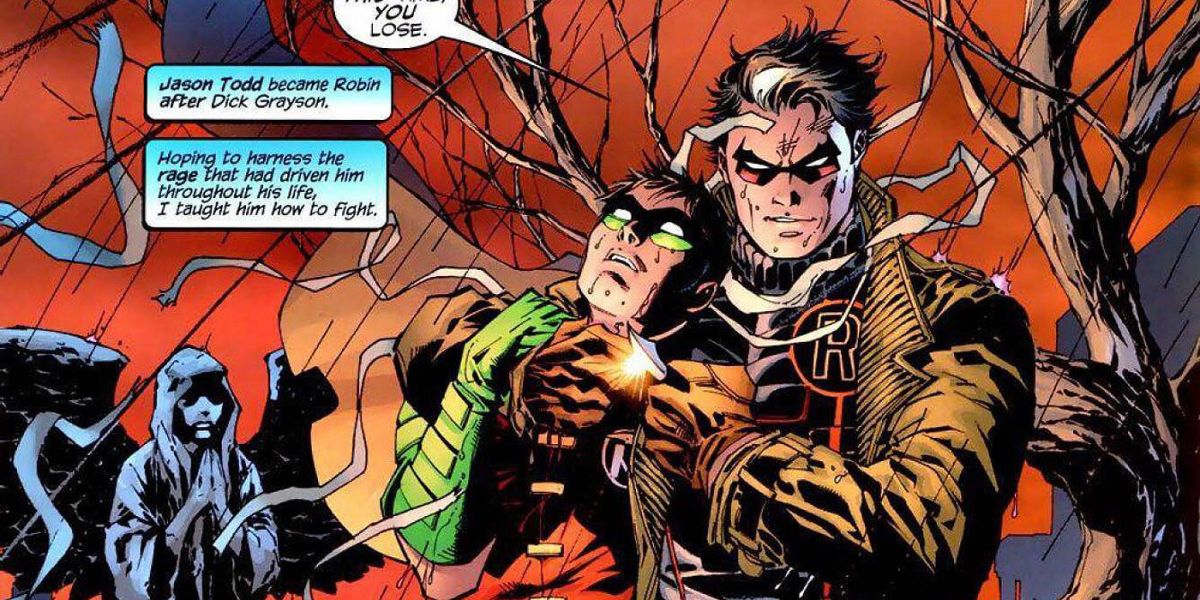 1988 was a big year for Joker. He’d always been a thorn in Batman’s side, but this year brought out his most sadistic attacks ever. First he crippled poor Barbara Gordon in Alan Moore’s The Killing Joke. Then he killed Robin, aka the second Robin, Jason Todd.
1988 was a big year for Joker. He’d always been a thorn in Batman’s side, but this year brought out his most sadistic attacks ever. First he crippled poor Barbara Gordon in Alan Moore’s The Killing Joke. Then he killed Robin, aka the second Robin, Jason Todd.
Todd was never terribly popular. Dick Grayson was a hard act to follow, and Jason’s rebellious nature didn’t do him any favors among Bat-fans. So DC held an event where readers were allowed to decide if Jason lived or died, using a 900 number. By a very small margin, death was the decision, so a story was written in which Jason was captured by Joker (with help from Jason’s long lost mother, no less) and left to die from a bomb blast.
Jason made his return in 2005 in the “Under the Hood” story arc, which introduced a new vigilante in town calling himself the Red Hood. He led his own gang and had a take-no-prisoners approach to “justice,” bringing him into conflict with Batman. It was later revealed that Jason had been revived by DC’s favorite back-from-the-dead plot device: a Lazarus Pit. He functioned as a nemesis for a while, and fought as to take on Batman’s persona during “Battle for the Cowl.” (He lost.)
The New 52 softened Jason a bit, making him an antihero instead of a villain, and a card-carrying member of the Bat-family. There’s tension and drama often between him and the other Robins, Batman, and even Batgirl, but they work together and mostly get along these days. He also fights alongside other “heroes” of a similar temperament — Arsenal and Starfire — in Red Hood and the Outlaws.
5. SCARLET WITCH
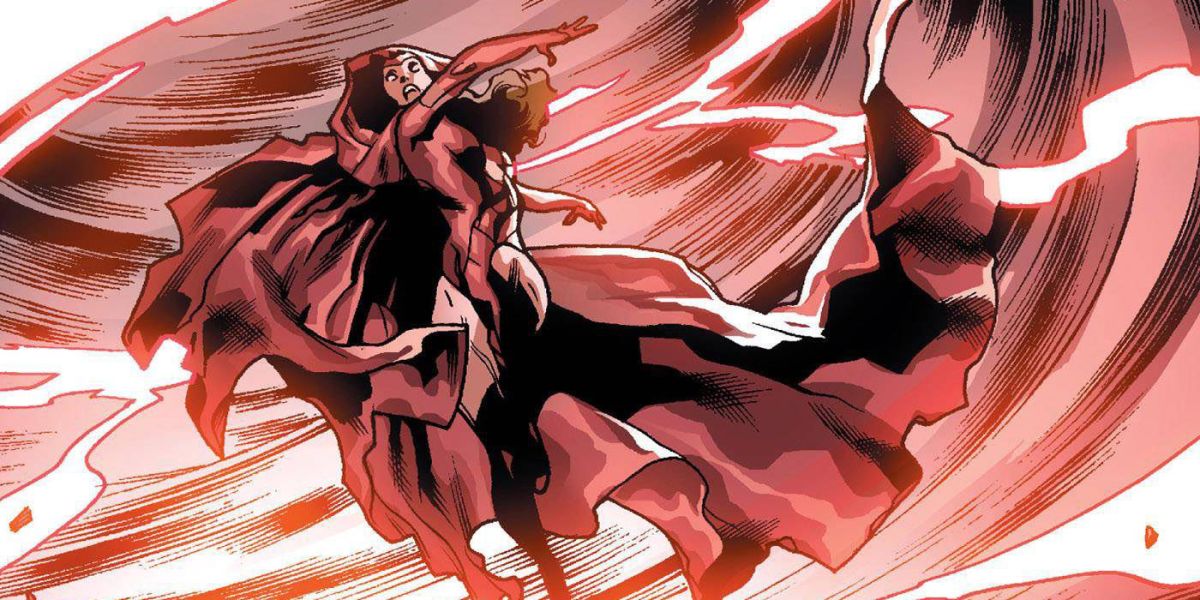 Back in 2004, Wanda Maximoff had a nervous breakdown and launched a magic-fueled attack on the Avengers that nearly destroyed them. Ant-Man, Hawkeye, and Vision were killed, Avengers Mansion was destroyed, and the Avengers disbanded. It was a story called “Avengers Disassembled,” and it paved the way for the launch of New Avengers in 2006, with A-list characters like Spider-Man and Wolverine added to the roster.
Back in 2004, Wanda Maximoff had a nervous breakdown and launched a magic-fueled attack on the Avengers that nearly destroyed them. Ant-Man, Hawkeye, and Vision were killed, Avengers Mansion was destroyed, and the Avengers disbanded. It was a story called “Avengers Disassembled,” and it paved the way for the launch of New Avengers in 2006, with A-list characters like Spider-Man and Wolverine added to the roster.
In her defense, learning that the twin boys you had with your android husband were just magical constructs and not real, and that your friends erased your memories of them, would send anybody over the edge. She later made mutants an endangered species. It was all retconned, of course, in order to allow Scarlet Witch back onto the team. Like most retcons, it was a tangled web of B.S. that explained away Wanda’s madness thanks to Dr. Doom’s mind control (aka, possession) and some random, cosmic being known as “the Lifeforce Entity” (aka, we know this sounds lame and don’t care enough to come up with something better).
Her kids were brought back to life in Young Avengers, and everyone that died in “Disassembled” was eventually restored to life in other titles. Scarlet Witch is currently a member of the Avengers Unity team — the one that combines Avengers and X-Men — in Uncanny Avengers. But she continues to occasionally deal with the consequences of her past.
4. SUPERBOY PRIME
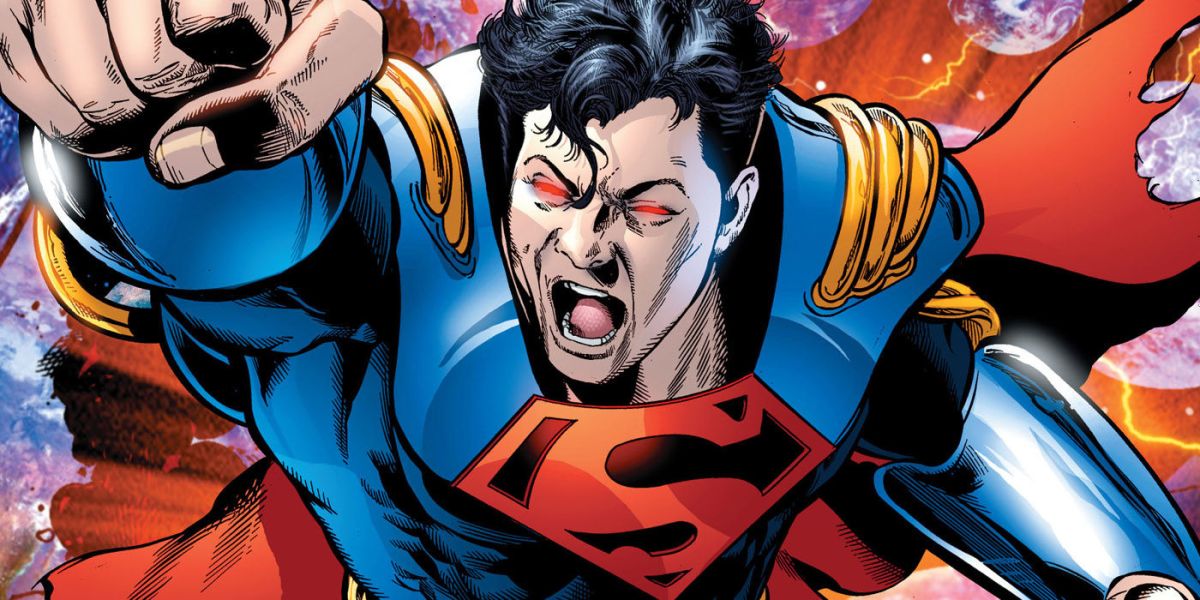 Superboy Prime, who debuted in Crisis on Infinite Earths as the Superboy of an alternate universe (our real-world universe, if you can believe it), is a classic study of a good guy gone bad. But at the end of the day, he was just a naive, immature brat who wasn’t ready for the expectations placed on him.
Superboy Prime, who debuted in Crisis on Infinite Earths as the Superboy of an alternate universe (our real-world universe, if you can believe it), is a classic study of a good guy gone bad. But at the end of the day, he was just a naive, immature brat who wasn’t ready for the expectations placed on him.
Along with Superman and Lois Lane of Earth-2 and Alexander Luthor of Earth-3, Superboy Prime was sequestered in a pocket dimension at the end of that first Crisis, as DC Comics’ multiple dimensions collapsed into one. Years later, they escaped that dimension in Infinite Crisis, which is when things went bad. Under the manipulation of Alexander Luthor, Prime turned evil, killed the mainstream continuity’s Superboy, and nearly wrecked the entire multiverse.
He stuck around for the duration, becoming ever more unhinged: he signed up with the yellow-ringed Sinestro Corps, got imprisoned in the main power battery on Oa, escaped and caused loads more mayhem, and eventually found his way back to Earth Prime. There, his parents had read about his dark deeds in the pages of DC Comics, and were understandably terrified to see him return. When last seen, he was imprisoned in the Source Wall at the edge of the universe by the Titans.
Then the New 52 reboot happened, and he hasn’t been seen since.
3. KID MARVELMAN
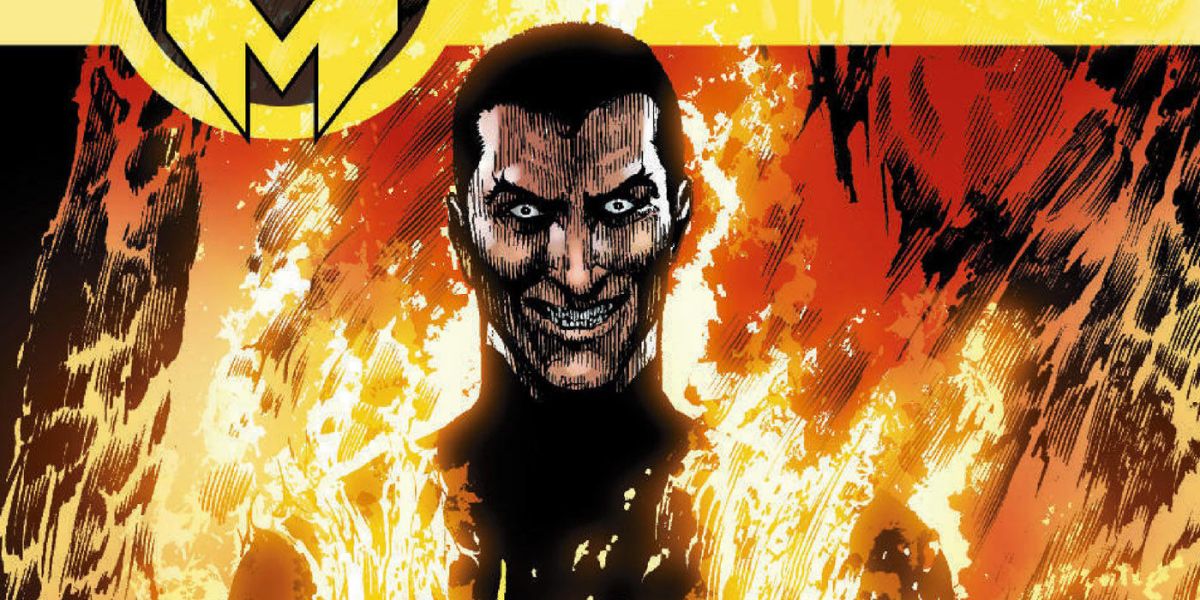 You may or may not have heard of Marvelman, an old superhero who was roughly the British equivalent of Captain Marvel, aka Shazam. Just like Billy Batson, all Michael Moran had to do to transform into a super-powered hero was utter the word, “Marvelman.” (There was some legal wrangling that required changing his name to “Miracleman” for a while, but it was eventually cleared up.)
You may or may not have heard of Marvelman, an old superhero who was roughly the British equivalent of Captain Marvel, aka Shazam. Just like Billy Batson, all Michael Moran had to do to transform into a super-powered hero was utter the word, “Marvelman.” (There was some legal wrangling that required changing his name to “Miracleman” for a while, but it was eventually cleared up.)
Like Batson, Moran had a sidekick; he was a young boy named Johnny Bates, and saying his magic word transformed him into Kid Marvelman. They and other allies, including Marvelwoman, had a long run of standard adventures, before being sidelined for almost 20 years. He resurfaced in 1982 thanks to a reimagining by the legendary Alan Moore.
In Moore’s update, Marvelman and Kid Marvelman were part of a secret government program who fell victim to a nuclear bomb attack. They both survived, though Michael Moran emerged with no memory of his superhero alter ego. Kid Marvelman believed he was the only survivor, and decided never to return to his child form, growing into a super-powered adult. This allowed him to mature his powers to an enormous degree. His disillusionment at being alone in the world and the power he amassed turned him into a vicious psychopath.
Kid Marvelman went on a rampage across London, destroying everything and killing most of the population. Redemption never came, as he was defeated and executed by his former mentor on the basis that he was too dangerous to be kept alive.
2. GREEN LANTERN
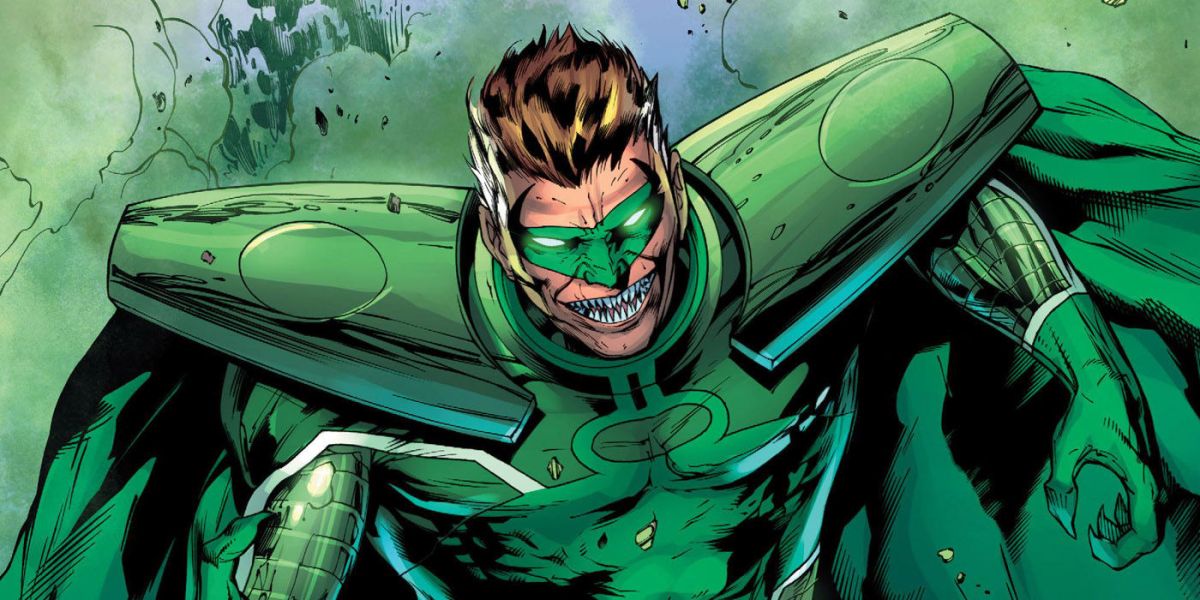 If there’s one thing the comics industry does not tolerate, it’s declining sales. It’s a surefire ticket to cancellation. But what if the title in question is a major book, starring one of the publisher’s cornerstone characters with a legacy going back decades?
If there’s one thing the comics industry does not tolerate, it’s declining sales. It’s a surefire ticket to cancellation. But what if the title in question is a major book, starring one of the publisher’s cornerstone characters with a legacy going back decades?
When that happens, it’s time for a creative revamp. In this case, DC Comics decided to ditch its longtime Green Lantern, Hal Jordan, in favor of a newer, hipper character named Kyle Rayner. But first, there was the pesky matter of what to do with Hal. The editorial team opted to have Hal go mad and transform into the ultimate supervillain, Parallax, thanks to his hometown of Coast City being destroyed and its seven million inhabitants killed.
Parallax went on a wild, destructive spree, ending the Green Lantern Corps., killing several of his fellow Lanterns, wiping the floor with the Justice League, and ultimately attempting to reshape the universe itself to his liking. He ran around like this for a few years before becoming the Spectre’s new host as a form of penance.
Jordan later returned to his life as Green Lantern after it was retconned that Parallax had been a separate entity that was possessing (there’s that word again) him the whole time. The whole thing was oddly similar to a seminal storyline from Marvel that predated the Parallax saga by some 13 years…
1. JEAN GREY
 In a 1979 X-Men arc, Jean Grey became the Phoenix, a nearly omnipotent cosmic force. It went okay for a while, but you know that old line about what absolute power does? That totally happened.
In a 1979 X-Men arc, Jean Grey became the Phoenix, a nearly omnipotent cosmic force. It went okay for a while, but you know that old line about what absolute power does? That totally happened.
Dark Phoenix destroyed an entire star system and threatened the existence of the universe itself, so something had to be done. The X-Men tried their best, but in the end it was Jean herself who ended Phoenix’s destructive binge. During battle, Jean’s true personality managed to surface long enough for her to take her own life, ending all of the horror and devastation.
A few years later, Marvel editorial decided they wanted Jean back. So the whole thing was retroactively changed that the Phoenix was a separate entity that had (wait for it…) possessed Jean, and that she had been at the bottom of the ocean in a cocoon, healing from injuries. Or something.
Jean died a second time after learning to control and wield the power of the Phoenix without it corrupting her. A younger version of Jean from before she became the Phoenix now exists — and is stuck — in the present, having been brought forward in time.
—
Who’s your favorite hero-turned-villain? Let us know in the comments.


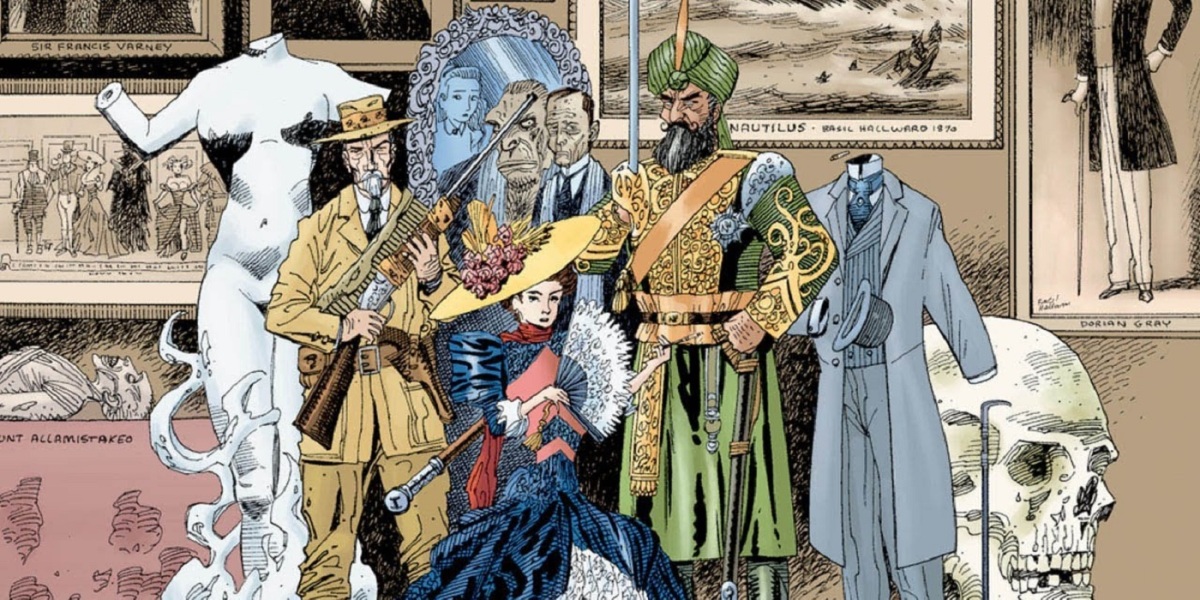 Kicking things off is a graphic novel with a team of superheroes (which will come up later) that is typically considered Alan Moore’s magnum opus, which is likely why The League of Extraordinary Gentlemen doesn’t get mentioned as much. It also probably didn’t help that its cinematic adaption wasn’t very good, but at least they’ll get another shot at success if the talk of a reboot winds up coming to fruition.
Kicking things off is a graphic novel with a team of superheroes (which will come up later) that is typically considered Alan Moore’s magnum opus, which is likely why The League of Extraordinary Gentlemen doesn’t get mentioned as much. It also probably didn’t help that its cinematic adaption wasn’t very good, but at least they’ll get another shot at success if the talk of a reboot winds up coming to fruition. One of the most recognizable groups from Marvel, even if their last three movies don’t exactly reflect that prestigious lineage. But it’s not that the characters are bad, it’s just that they were placed in disappointing stories. So maybe Fox needs to take a cue from what Sony is doing with Spider-Man, and let the better established MCU take a crack at making the Fantastic Four look a little more, well, fantastic.
One of the most recognizable groups from Marvel, even if their last three movies don’t exactly reflect that prestigious lineage. But it’s not that the characters are bad, it’s just that they were placed in disappointing stories. So maybe Fox needs to take a cue from what Sony is doing with Spider-Man, and let the better established MCU take a crack at making the Fantastic Four look a little more, well, fantastic.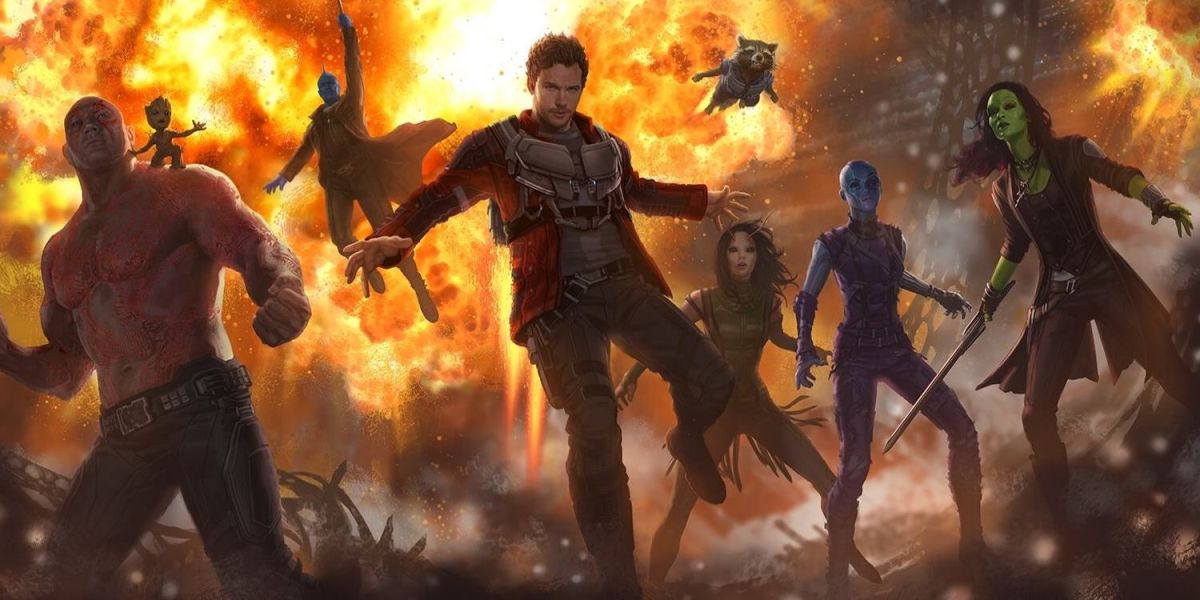 When the Guardians of the Galaxy movie was first announced, many viewers could only react by asking, “Who?” It also didn’t help that many of the actors were buried under elaborate makeup, or transformed into different species via CGI, lending the film few familiar faces to draw in non-fans. And yet, its attitude of old school fun and adventure hooked moviegoers, and elevated this group of unknowns into one of the most talked about films of 2014.
When the Guardians of the Galaxy movie was first announced, many viewers could only react by asking, “Who?” It also didn’t help that many of the actors were buried under elaborate makeup, or transformed into different species via CGI, lending the film few familiar faces to draw in non-fans. And yet, its attitude of old school fun and adventure hooked moviegoers, and elevated this group of unknowns into one of the most talked about films of 2014.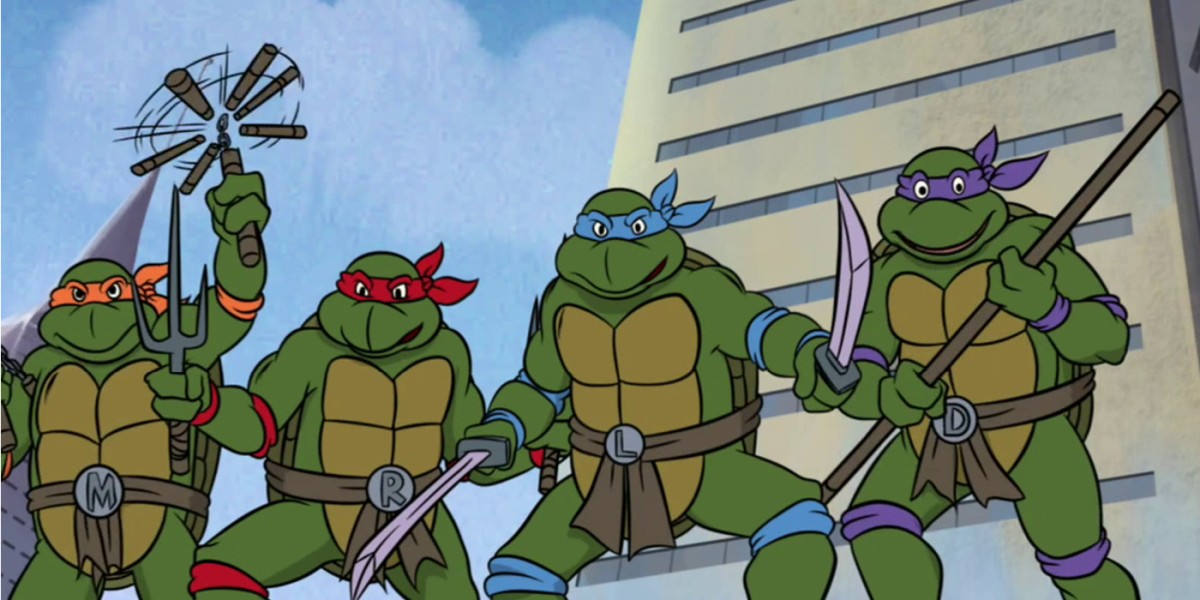 The ’80s and ’90s were an odd time for new kid’s characters, as demonstrated by this bunch of giant teenaged turtles who live in the sewer, munch on pizza, and use ninja weapons to take down their foes. And yet, the Teenage Mutant Ninja Turtles proved to be something special, possessing some unique spark that their copycat competitors (including giant sharks, giant mice, and pachyderms) were unable to recapture.
The ’80s and ’90s were an odd time for new kid’s characters, as demonstrated by this bunch of giant teenaged turtles who live in the sewer, munch on pizza, and use ninja weapons to take down their foes. And yet, the Teenage Mutant Ninja Turtles proved to be something special, possessing some unique spark that their copycat competitors (including giant sharks, giant mice, and pachyderms) were unable to recapture.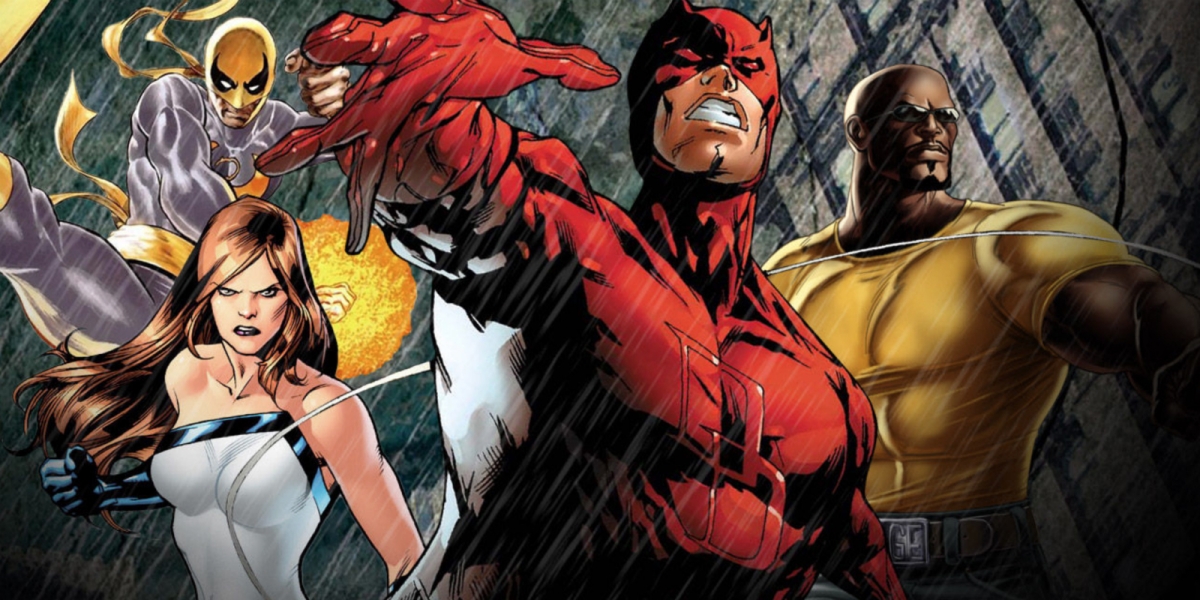 Say one thing for Marvel, they sure know how to invest the time into a slow-build leading up to the formation of a super team. Rather than rush into a Defenders TV series, we’ve instead had Netflix’s Daredevil, Jessica Jones, and soon Luke Cage and Iron Fist as well. This will ultimately build into the formation of a supergroup comprised of the four heroes, Avengers-style, known as the Defenders.
Say one thing for Marvel, they sure know how to invest the time into a slow-build leading up to the formation of a super team. Rather than rush into a Defenders TV series, we’ve instead had Netflix’s Daredevil, Jessica Jones, and soon Luke Cage and Iron Fist as well. This will ultimately build into the formation of a supergroup comprised of the four heroes, Avengers-style, known as the Defenders. Any team that includes Deadpool, Psylocke, and Wolverine fighting together would have to try pretty hard to suck. Sure, they’re just part of the more recent Uncanny X-Force, but that’s also the iteration that makes the most sense to base a movie on right now. Thanks to the X-Men film franchise, we’re well-acquainted with Wolverine, we just saw what Psylocke could do in X-Men: Apocalypse, and of course everyone knows about Deadpool by this point. There’s definitely the potential to bring those characters together and give fans a treat.
Any team that includes Deadpool, Psylocke, and Wolverine fighting together would have to try pretty hard to suck. Sure, they’re just part of the more recent Uncanny X-Force, but that’s also the iteration that makes the most sense to base a movie on right now. Thanks to the X-Men film franchise, we’re well-acquainted with Wolverine, we just saw what Psylocke could do in X-Men: Apocalypse, and of course everyone knows about Deadpool by this point. There’s definitely the potential to bring those characters together and give fans a treat. You’ve got to admire the parenting skills of a man who adopts strangers and dresses them in bat-related costumes to help him fight crime. From Nightwing, to Batgirl, to all the different Robins, probably no other character has helped create as many noteworthy heroes as Batman. Despite Batman’s well-known reclusive nature, he understands the need for successors to whom he can entrust the safety of Gotham should he ever have to step down. And through that planning for the future, he’s wound up creating a pretty effective team of heroes to rely on for the present.
You’ve got to admire the parenting skills of a man who adopts strangers and dresses them in bat-related costumes to help him fight crime. From Nightwing, to Batgirl, to all the different Robins, probably no other character has helped create as many noteworthy heroes as Batman. Despite Batman’s well-known reclusive nature, he understands the need for successors to whom he can entrust the safety of Gotham should he ever have to step down. And through that planning for the future, he’s wound up creating a pretty effective team of heroes to rely on for the present.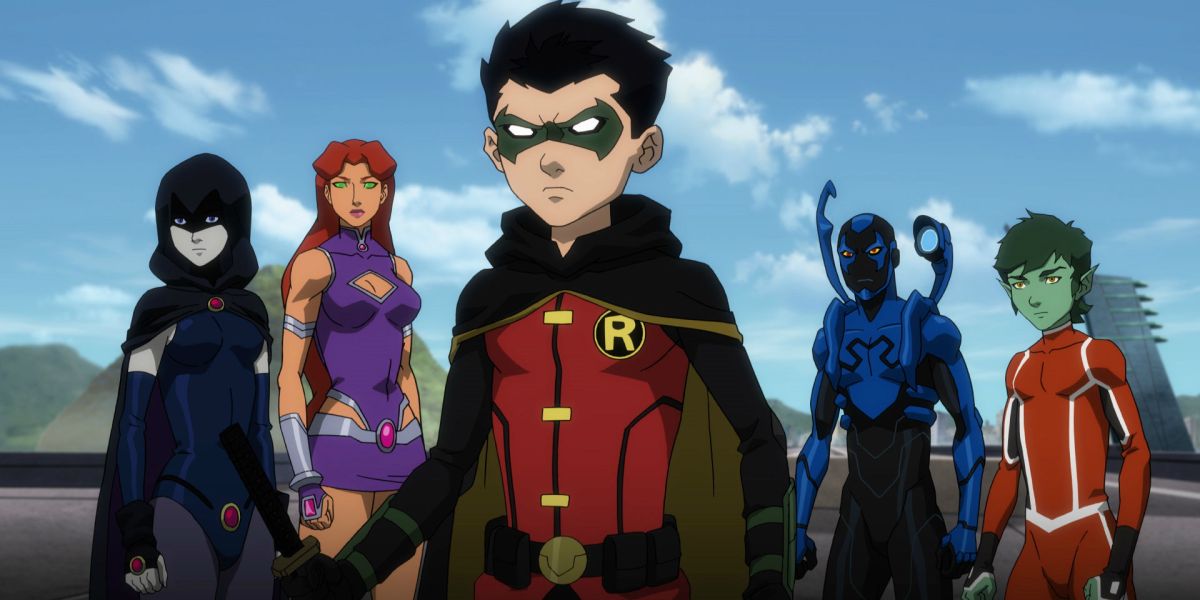 It might hurt Batman’s feelings, but it’s arguable that Robin’s greatest success came after he stepped out from the shadow of the Dark Knight and instead took the lead in his own group of heroes. Fans of the Teen Titans show (no, not Teen Titans Go!) will know the line up as Robin, Cyborg, Starfire, Beast Boy, and Raven, but the group has actually been a sort of junior Justice League for many adolescent heroes.
It might hurt Batman’s feelings, but it’s arguable that Robin’s greatest success came after he stepped out from the shadow of the Dark Knight and instead took the lead in his own group of heroes. Fans of the Teen Titans show (no, not Teen Titans Go!) will know the line up as Robin, Cyborg, Starfire, Beast Boy, and Raven, but the group has actually been a sort of junior Justice League for many adolescent heroes. Dating back to the early ’40s, the Justice Society of America is mandatory for inclusion in a topic like this since they were the ones who started it all. Before the Justice Society, there were no superhero teams in comics. For those of you less familiar with the group, you’re probably already wondering at a connection to the Justice League. And the answer is yes, the Justice Society was a precursor to the Justice League, and even had some of the same members. But that doesn’t make them the same entity.
Dating back to the early ’40s, the Justice Society of America is mandatory for inclusion in a topic like this since they were the ones who started it all. Before the Justice Society, there were no superhero teams in comics. For those of you less familiar with the group, you’re probably already wondering at a connection to the Justice League. And the answer is yes, the Justice Society was a precursor to the Justice League, and even had some of the same members. But that doesn’t make them the same entity.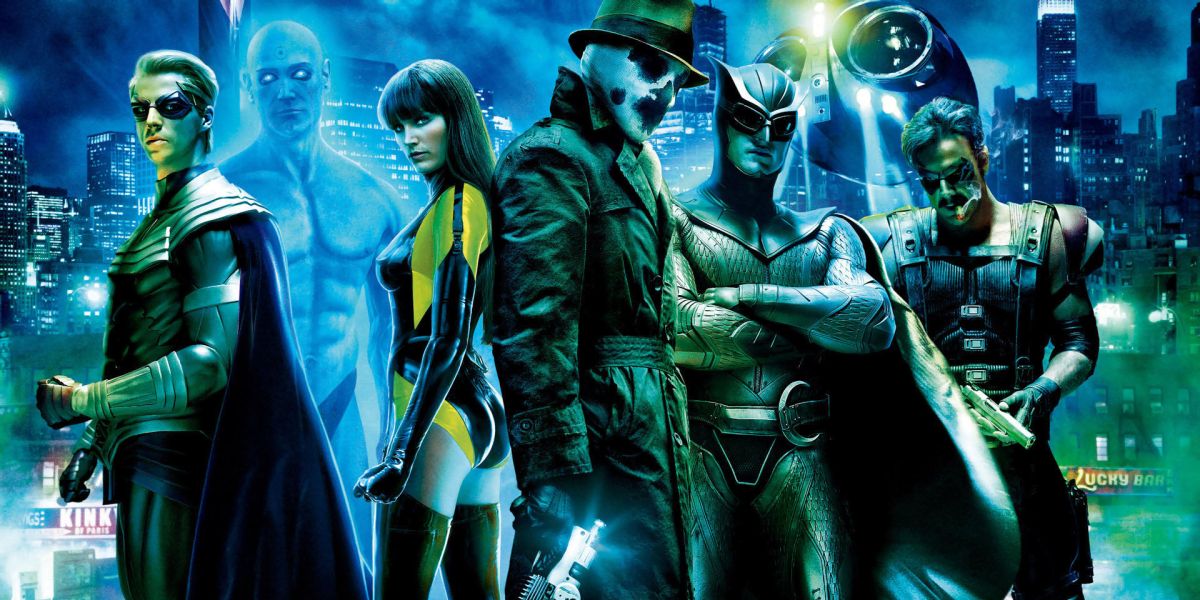 Due to the consolidated nature of their story, The Watchmen are one of the less talked about groups of heroes out there. There’re no more movies that can be told about their story, no more years of comics of them as a team, and certainly no cartoons. And yet, the lone graphic novel they starred in has gone down in comics history as one of the most influential and revolutionary works in the genre.
Due to the consolidated nature of their story, The Watchmen are one of the less talked about groups of heroes out there. There’re no more movies that can be told about their story, no more years of comics of them as a team, and certainly no cartoons. And yet, the lone graphic novel they starred in has gone down in comics history as one of the most influential and revolutionary works in the genre.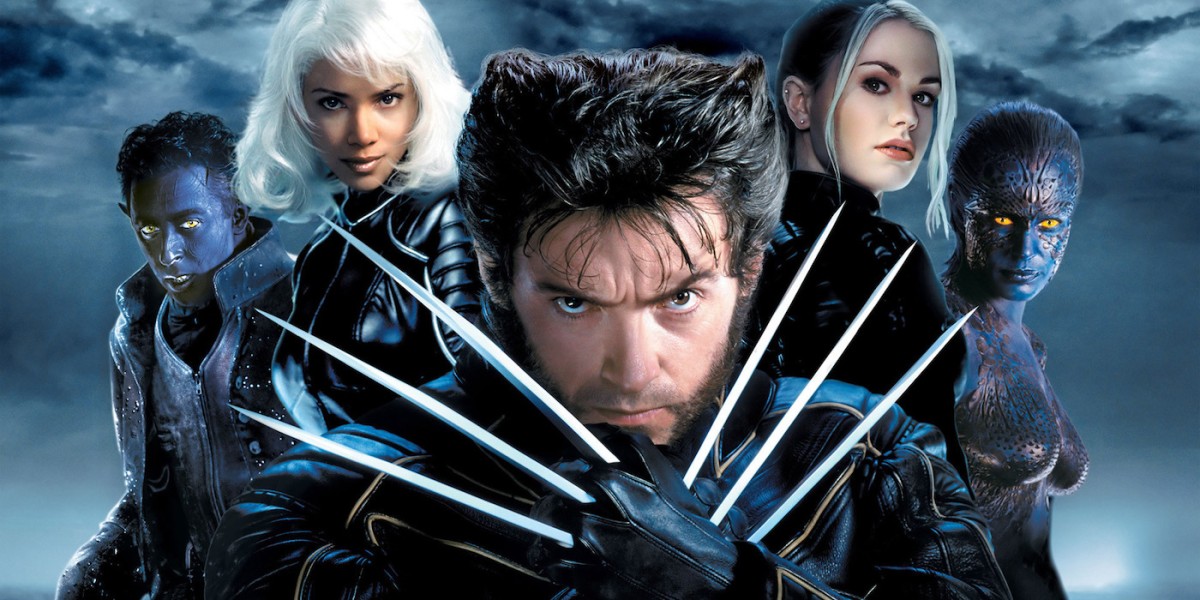 When you can overcome ostentatious yellow jumpsuits, and have fans be cool with there being blue furries in your superhero group, that’s a good sign your team has made it to the big time. Even more impressive is that while the next two entries will talk about groups that formed after the individual heroes were already popular, the X-Men are arguably just as popular as either of those teams, despite the original members all being introduced at once and having to fight for the spotlight. It’s hard enough getting one character to catch on at a time, let alone half a dozen.
When you can overcome ostentatious yellow jumpsuits, and have fans be cool with there being blue furries in your superhero group, that’s a good sign your team has made it to the big time. Even more impressive is that while the next two entries will talk about groups that formed after the individual heroes were already popular, the X-Men are arguably just as popular as either of those teams, despite the original members all being introduced at once and having to fight for the spotlight. It’s hard enough getting one character to catch on at a time, let alone half a dozen.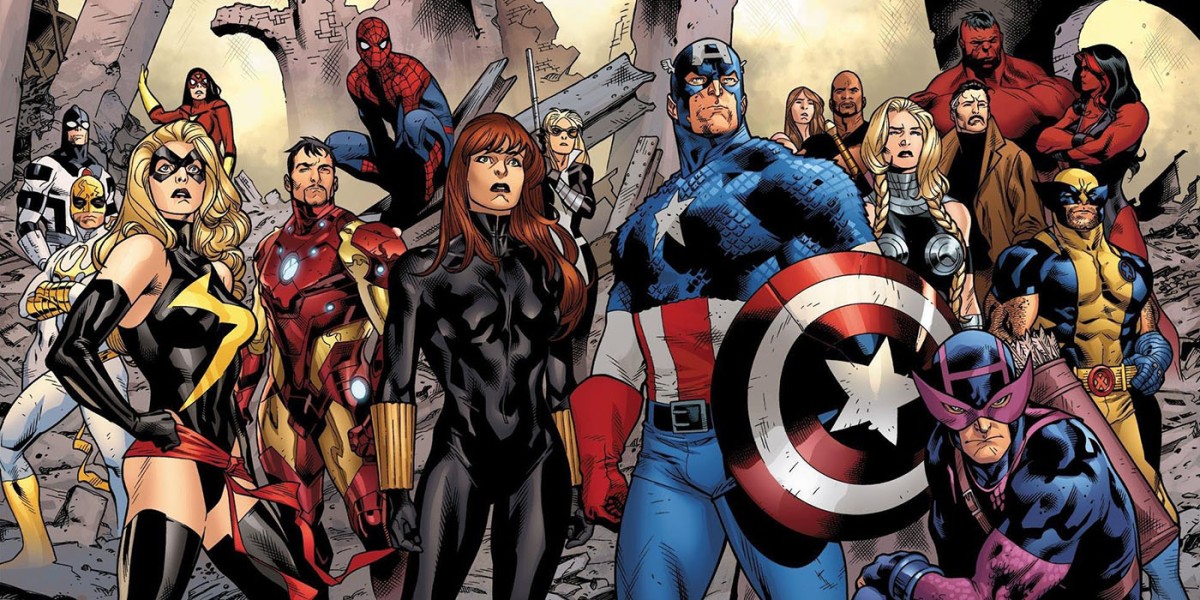 You knew from the intro that the Avengers were going to rank highly here, and it was really just a matter of whether they’d be number one or number two. A great case can be made for either spot, regardless of whether you cling to some strict allegiance to DC or Marvel. The Avengers have a long history together in comic books, but they got edged out of the top spot by just a hair here– by a group that’s been around slightly longer.
You knew from the intro that the Avengers were going to rank highly here, and it was really just a matter of whether they’d be number one or number two. A great case can be made for either spot, regardless of whether you cling to some strict allegiance to DC or Marvel. The Avengers have a long history together in comic books, but they got edged out of the top spot by just a hair here– by a group that’s been around slightly longer. And finally we come to the group of heroes with one of the longest histories together, and also quite possibly the best group out there. Like many long running teams, the members involved have changed drastically over the years, to the point that all the founders have eventually been swapped out for other heroes. But for this entry, we’re focusing on the original team, comprised of Superman, Wonder Woman, Aquaman, Martian Manhunter, the Flash, Green Lantern, and Batman. Separately, they are some of the most powerful heroes in existence. Together, you really can’t find a more powerful group.
And finally we come to the group of heroes with one of the longest histories together, and also quite possibly the best group out there. Like many long running teams, the members involved have changed drastically over the years, to the point that all the founders have eventually been swapped out for other heroes. But for this entry, we’re focusing on the original team, comprised of Superman, Wonder Woman, Aquaman, Martian Manhunter, the Flash, Green Lantern, and Batman. Separately, they are some of the most powerful heroes in existence. Together, you really can’t find a more powerful group.
 Although there has been more than one Ant-Man over the years, the original hero to hold that title (Hank Pym) was married twice in his history, once to another bug-style super: The Wasp (Janet Van Dyne). Hank’s first wife, Maria Troyova, appears only in Hank’s backstory. Her tragic death led to Hank’s breakdown and a refocusing of his research, which resulted in the discovery of the Pym Particles that allowed him to shrink and grow at will.
Although there has been more than one Ant-Man over the years, the original hero to hold that title (Hank Pym) was married twice in his history, once to another bug-style super: The Wasp (Janet Van Dyne). Hank’s first wife, Maria Troyova, appears only in Hank’s backstory. Her tragic death led to Hank’s breakdown and a refocusing of his research, which resulted in the discovery of the Pym Particles that allowed him to shrink and grow at will. Although we’ve seen a lot of the Flash on the small screen (including both of these characters), it’s unlikely that we’ll actually see Wally West and Linda Park get together in the TV series, as Linda dated Barry before leaving Central City. In the comics, Linda Park is a reporter in Keystone City, whose relationship with Wally gets off to a rocky start but slowly blossoms into love. The two have a relationship that truly knows no bounds – it was his love for Linda that brought Wally back from the Speed Force, after which Wally was able to save Linda when she was “killed” by the Black Flash (but was really inside the Speed Force).
Although we’ve seen a lot of the Flash on the small screen (including both of these characters), it’s unlikely that we’ll actually see Wally West and Linda Park get together in the TV series, as Linda dated Barry before leaving Central City. In the comics, Linda Park is a reporter in Keystone City, whose relationship with Wally gets off to a rocky start but slowly blossoms into love. The two have a relationship that truly knows no bounds – it was his love for Linda that brought Wally back from the Speed Force, after which Wally was able to save Linda when she was “killed” by the Black Flash (but was really inside the Speed Force). Originally part of the Wildstorm universe, Apollo and Midnighter are both super-soldiers who were given superpowers by Henry Bendix as he created the Stormwatch team. The two fell in love while in hiding after their first mission went bad and Bendix refused to pull them out. The two are inseparable, earning themselves the nicknames “Bert and Ernie”.
Originally part of the Wildstorm universe, Apollo and Midnighter are both super-soldiers who were given superpowers by Henry Bendix as he created the Stormwatch team. The two fell in love while in hiding after their first mission went bad and Bendix refused to pull them out. The two are inseparable, earning themselves the nicknames “Bert and Ernie”. The original Hourman, Rex Tyler, may be making his way into pop culture consciousness with his upcoming appearances on the CW series Legends of Tomorrow (played by Suits‘ Patrick J. Adams). However, it’s his son, Rick Tyler, who married another superhero – Jesse Chambers, aka Liberty Belle. (Rex Tyler also married, a non-super named Wendy Harris.)
The original Hourman, Rex Tyler, may be making his way into pop culture consciousness with his upcoming appearances on the CW series Legends of Tomorrow (played by Suits‘ Patrick J. Adams). However, it’s his son, Rick Tyler, who married another superhero – Jesse Chambers, aka Liberty Belle. (Rex Tyler also married, a non-super named Wendy Harris.) The greatest warrior of Apokolips and leader of Darkseid’s personal guard, the Female Furies, Big Barda is a warrior woman in the greatest sense – which makes her marriage and desire to live a ‘normal’ life all the more interesting. Initially enemies, Barda and Scott Free worked together to help Scott escape Apokolips, and when Barda also decided to leave Darkseid, the two began to fall in love. Scott became the famous escape-artist Mister Miracle, but both he and Barda attempted to give up their heroics and settle down for a time, simply being a normal married couple.
The greatest warrior of Apokolips and leader of Darkseid’s personal guard, the Female Furies, Big Barda is a warrior woman in the greatest sense – which makes her marriage and desire to live a ‘normal’ life all the more interesting. Initially enemies, Barda and Scott Free worked together to help Scott escape Apokolips, and when Barda also decided to leave Darkseid, the two began to fall in love. Scott became the famous escape-artist Mister Miracle, but both he and Barda attempted to give up their heroics and settle down for a time, simply being a normal married couple.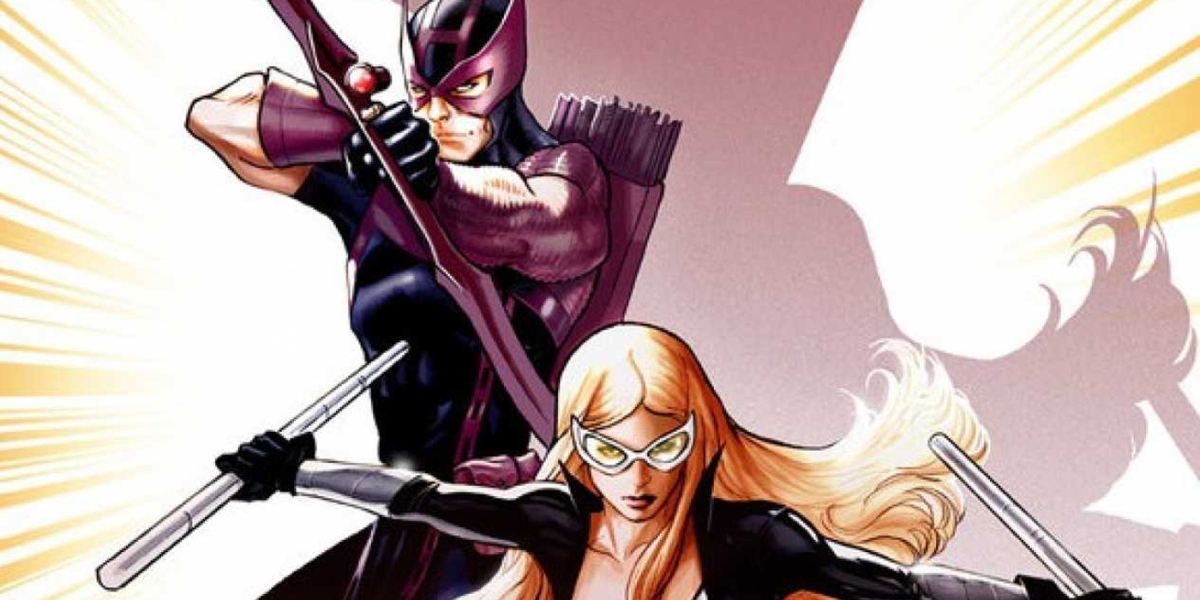 Both Hawkeye (Jeremy Renner) and Mockingbird (Adrianne Palicki) are well-established members of the Marvel Cinematic Universe, but we don’t expect to see their comic book marriage on screen any time soon. Hawkeye revealed that he is already happily married in Avengers: Age of Ultron, and Bobbi Morse has her own relationship with ex-husband Lance Hunter on Agents of S.H.I.E.L.D.
Both Hawkeye (Jeremy Renner) and Mockingbird (Adrianne Palicki) are well-established members of the Marvel Cinematic Universe, but we don’t expect to see their comic book marriage on screen any time soon. Hawkeye revealed that he is already happily married in Avengers: Age of Ultron, and Bobbi Morse has her own relationship with ex-husband Lance Hunter on Agents of S.H.I.E.L.D.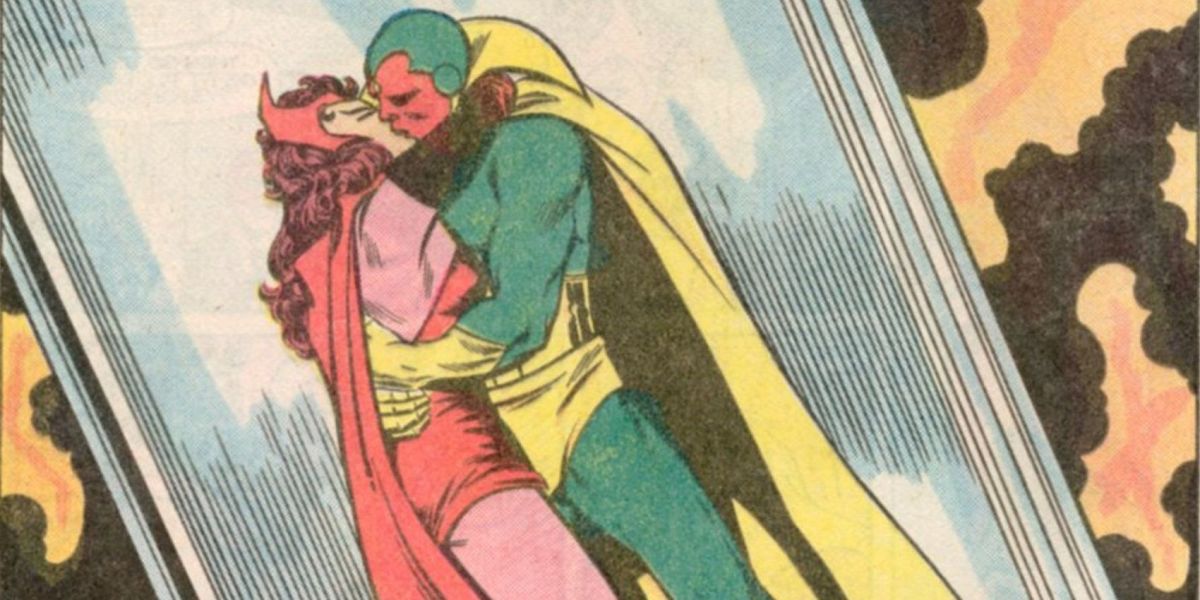 To say that Vision and Wanda have had a tumultuous romantic history would be putting it mildly, as these two have separated and re-united multiple times over the years. Vision and Scarlet Witch first got together when they were both members of the Avengers, which was relatively early on in Vision’s comic book history. Despite the fact that Wanda’s brother, Pietro, didn’t approve of the relationship (and why would he, Vision isn’t even human), she and the synthesized android fell in love and eventually got married.
To say that Vision and Wanda have had a tumultuous romantic history would be putting it mildly, as these two have separated and re-united multiple times over the years. Vision and Scarlet Witch first got together when they were both members of the Avengers, which was relatively early on in Vision’s comic book history. Despite the fact that Wanda’s brother, Pietro, didn’t approve of the relationship (and why would he, Vision isn’t even human), she and the synthesized android fell in love and eventually got married. Two of the most famous African superheroes in the Marvel Universe, Black Panther (T’Challa) and Storm (Ororo Monroe) each have a long history of their own and are usually seen fighting apart. But for a time, the two were actually husband and wife. Ororo and T’Challa met when the X-Men teamed up with Black Panther, and after fighting side by side on more than one occasion, the two developed a romantic attraction. After the events of M-Day, when most mutants were de-powered, Ororo returned to Africa where her romance with T’Challa blossomed, and the two were married in Wakanda. This made Ororo Queen of Wakanda, and she has even taking political control of the secret nation in the past.
Two of the most famous African superheroes in the Marvel Universe, Black Panther (T’Challa) and Storm (Ororo Monroe) each have a long history of their own and are usually seen fighting apart. But for a time, the two were actually husband and wife. Ororo and T’Challa met when the X-Men teamed up with Black Panther, and after fighting side by side on more than one occasion, the two developed a romantic attraction. After the events of M-Day, when most mutants were de-powered, Ororo returned to Africa where her romance with T’Challa blossomed, and the two were married in Wakanda. This made Ororo Queen of Wakanda, and she has even taking political control of the secret nation in the past.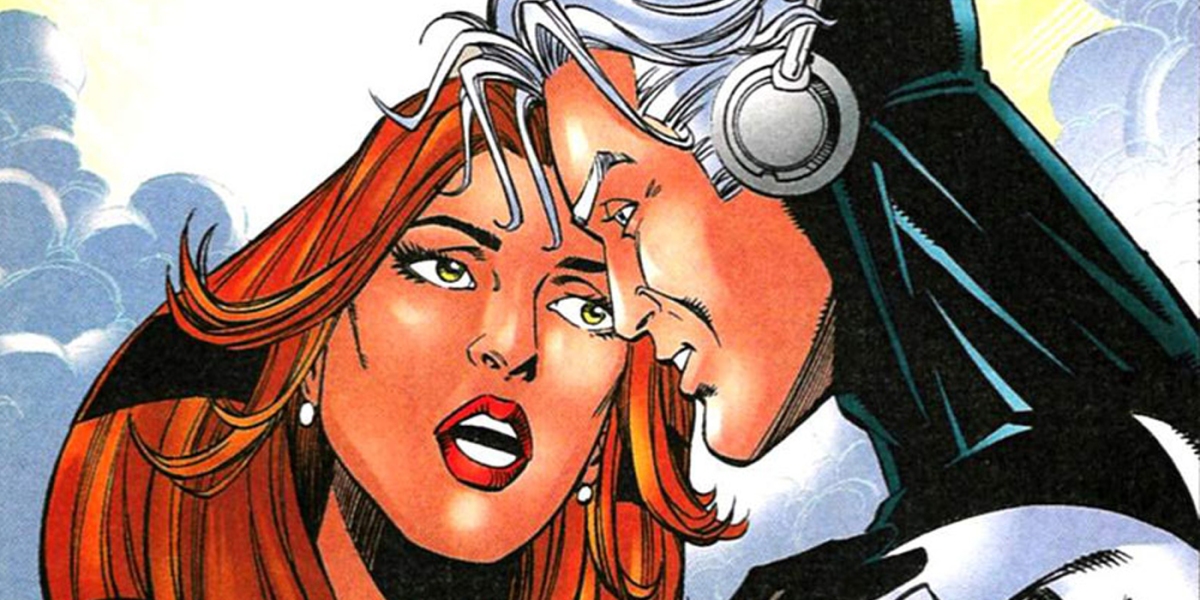 One of the most on-again-off-again relationships in comics, the mutant speedster Quicksilver and Inhuman Crystal have a long and tumultuous history. When Crystal first came to New York from the Inhuman city of Attilan, she set her sights on a different superhero – Johnny Storm. The two had a relationship, and Crystal even joined the Fantastic Four for a time. However, when she met a wounded Quicksilver and nursed him back to health, Crystal fell for the speedster and ended her relationship with Johnny.
One of the most on-again-off-again relationships in comics, the mutant speedster Quicksilver and Inhuman Crystal have a long and tumultuous history. When Crystal first came to New York from the Inhuman city of Attilan, she set her sights on a different superhero – Johnny Storm. The two had a relationship, and Crystal even joined the Fantastic Four for a time. However, when she met a wounded Quicksilver and nursed him back to health, Crystal fell for the speedster and ended her relationship with Johnny. Bruce Wayne may be better known for his complicated romantic history with Catwoman, but he’s been married to someone else – the daughter of his great enemy, Ra’s Al Ghul. Talia first met Bruce Wayne when he rescued her from Doctor Darrk, and she quickly started to fall in love with the enigmatic Dark Knight. Ra’s, seeing this, sets a test to see if Batman could be worthy of his daughter (and to become the head of the League in his place). Bruce passes (obviously, he’s Batman!), but rejects the offer.
Bruce Wayne may be better known for his complicated romantic history with Catwoman, but he’s been married to someone else – the daughter of his great enemy, Ra’s Al Ghul. Talia first met Bruce Wayne when he rescued her from Doctor Darrk, and she quickly started to fall in love with the enigmatic Dark Knight. Ra’s, seeing this, sets a test to see if Batman could be worthy of his daughter (and to become the head of the League in his place). Bruce passes (obviously, he’s Batman!), but rejects the offer.








 John Constantine represents one of the more interesting character crossovers in the Arrowverse. Though well received by fans and critics alike, low ratings lead NBC to cancel his solo series Constantine after just 13 episodes. While a second season may appear to be a long shot right now, actor Matt Ryan got to throw on the character’s signature trench coat one last time on a season four episode of Arrow.
John Constantine represents one of the more interesting character crossovers in the Arrowverse. Though well received by fans and critics alike, low ratings lead NBC to cancel his solo series Constantine after just 13 episodes. While a second season may appear to be a long shot right now, actor Matt Ryan got to throw on the character’s signature trench coat one last time on a season four episode of Arrow.

 The character of Cisco Ramon is one of The Flash’s most popular, but he is also one that is drastically different from the comic book character that bears the same name. While fans of the show may be used to the stream of pop culture references from the licorice-loving Cisco we’ve come to know and love, this is a far cry from his comic books origins.
The character of Cisco Ramon is one of The Flash’s most popular, but he is also one that is drastically different from the comic book character that bears the same name. While fans of the show may be used to the stream of pop culture references from the licorice-loving Cisco we’ve come to know and love, this is a far cry from his comic books origins.









 There have been three Black Widows in the Marvel Universe. The first Black Widow is Claire Voyant, an antiheroic witch who uses magic in order to banish souls to Hell. The second one is the most popular. Natalia Alianovna “Natasha” Romanova AKA Black Widow is a super-spy. She first appeared working for the Russians as an antagonist in the “Iron Man” titles. However, she later started working for SHIELD and became an Avenger. Although she did not have any superpowers, she was a very important and useful member due to her combat, leadership and spying skills. The third one is Yelena Belova, another spy and assassin who was trained by the spymasters who trained the second one.
There have been three Black Widows in the Marvel Universe. The first Black Widow is Claire Voyant, an antiheroic witch who uses magic in order to banish souls to Hell. The second one is the most popular. Natalia Alianovna “Natasha” Romanova AKA Black Widow is a super-spy. She first appeared working for the Russians as an antagonist in the “Iron Man” titles. However, she later started working for SHIELD and became an Avenger. Although she did not have any superpowers, she was a very important and useful member due to her combat, leadership and spying skills. The third one is Yelena Belova, another spy and assassin who was trained by the spymasters who trained the second one.

























 Wonder Woman will finally have her own feature film in 2017. She may be a household name now, as well as the fantasy of many a geek boy’s (and girl’s!) dreams, but originally she was supposed to be named Suprema.
Wonder Woman will finally have her own feature film in 2017. She may be a household name now, as well as the fantasy of many a geek boy’s (and girl’s!) dreams, but originally she was supposed to be named Suprema.
 Speaking of movies, contrary to what many think, the first movie about Batman was not the 1966 film starring Adam West, Batman: The Movie.
Speaking of movies, contrary to what many think, the first movie about Batman was not the 1966 film starring Adam West, Batman: The Movie. One cannot talk about Batman without also mentioning his ultimate adversary, the Joker. And these days, the green-haired psychotic killer is often seen hand-in-hand with his on-again-off-again love, Harley Quinn.
One cannot talk about Batman without also mentioning his ultimate adversary, the Joker. And these days, the green-haired psychotic killer is often seen hand-in-hand with his on-again-off-again love, Harley Quinn. One of the many times the Joker put the entire free world in danger was in the late 1980s Batman series, A Death in The Family. The book featured the Joker as the Iranian Ambassador to the U.N. He was appointed to the position by the Iranian leader, Ayatollah Khomeini, himself.
One of the many times the Joker put the entire free world in danger was in the late 1980s Batman series, A Death in The Family. The book featured the Joker as the Iranian Ambassador to the U.N. He was appointed to the position by the Iranian leader, Ayatollah Khomeini, himself. Batman’s look may have altered over the decades, but certain iconic pieces remained to keep him recognizable as the Dark Knight: his dark suit and cape, and his pointed-ear cowl.
Batman’s look may have altered over the decades, but certain iconic pieces remained to keep him recognizable as the Dark Knight: his dark suit and cape, and his pointed-ear cowl. With his red and blue costume and his immovable drive to fight for the values of truth and justice, Superman has been seen as the ultimate American superhero (co-created by Canadian artist, Joseph “Joe” Shuster). But what if Kal-El’s pod from Krypton did not land in a farm in Kansas? What if Superman had grown up in the United Kingdom instead?
With his red and blue costume and his immovable drive to fight for the values of truth and justice, Superman has been seen as the ultimate American superhero (co-created by Canadian artist, Joseph “Joe” Shuster). But what if Kal-El’s pod from Krypton did not land in a farm in Kansas? What if Superman had grown up in the United Kingdom instead? If a British Superman isn’t far-fetched enough, in the previous year, the Elseworlds series also published a three-issue book featuring a Superman who had been raised in the Soviet Union.
If a British Superman isn’t far-fetched enough, in the previous year, the Elseworlds series also published a three-issue book featuring a Superman who had been raised in the Soviet Union. Many different versions of Superman certainly exist in many parallel universes and reimagined storylines, but even the most recognizable version of Superman we know today did not always have the powers he is most well known for.
Many different versions of Superman certainly exist in many parallel universes and reimagined storylines, but even the most recognizable version of Superman we know today did not always have the powers he is most well known for.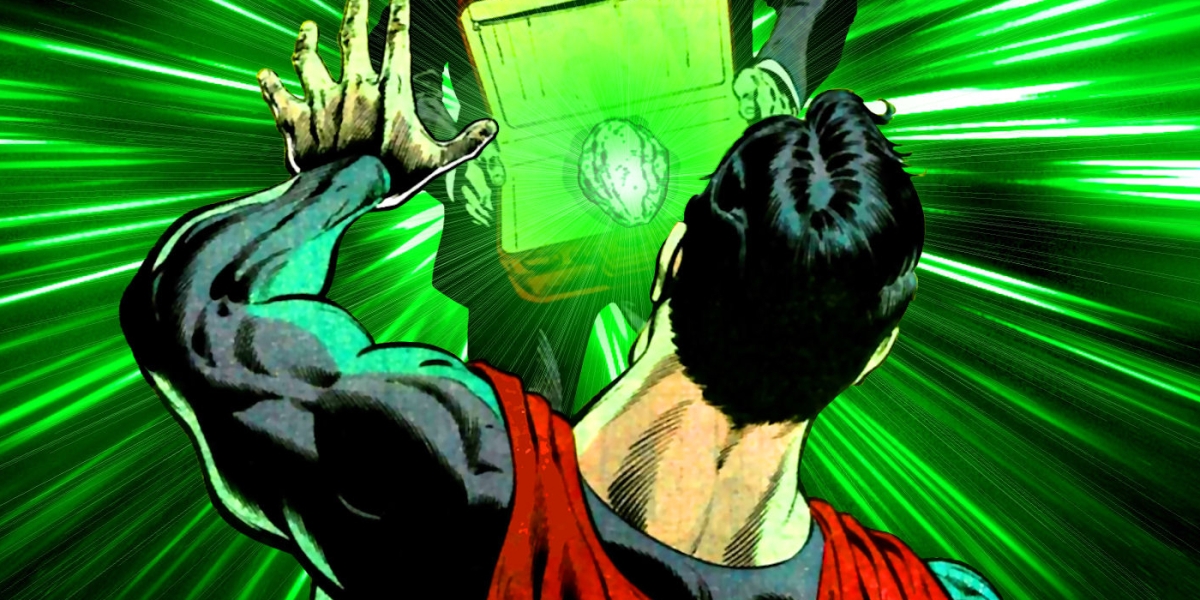 Superman’s most known and most exploited weakness, kryptonite, was also not originally in his story.
Superman’s most known and most exploited weakness, kryptonite, was also not originally in his story. Another detail that fans and observers like to poke fun at is Superman’s disguise as mild-mannered reporter, Clark Kent. How is no one able to recognize him just because he puts on a pair of glasses?
Another detail that fans and observers like to poke fun at is Superman’s disguise as mild-mannered reporter, Clark Kent. How is no one able to recognize him just because he puts on a pair of glasses? Lois Lane, Lex Luthor, Lana Lang – Superman’s world seems to be filled with people with the initials L.L. Although there has never been an official reason for this, some have speculated that what started as a coincidence then turned into a running joke.
Lois Lane, Lex Luthor, Lana Lang – Superman’s world seems to be filled with people with the initials L.L. Although there has never been an official reason for this, some have speculated that what started as a coincidence then turned into a running joke. Lex Luthor’s name was not the only detail that went through a major change. When he first appeared in Action Comics #23 in 1940, he debuted with his plans to take over the world, complete with a full head of ginger hair.
Lex Luthor’s name was not the only detail that went through a major change. When he first appeared in Action Comics #23 in 1940, he debuted with his plans to take over the world, complete with a full head of ginger hair. Lex Luthor was not the only villain Superman had to face. Another major bald-headed adversary was Brainiac, who first appeared in 1958’s Action Comics #242. He was responsible for shrinking and stealing Kandor, the capital city of Superman’s home planet, Krypton.
Lex Luthor was not the only villain Superman had to face. Another major bald-headed adversary was Brainiac, who first appeared in 1958’s Action Comics #242. He was responsible for shrinking and stealing Kandor, the capital city of Superman’s home planet, Krypton. We now know that Superman is not the only survivor of Krypton. Among the many who survived the destruction of their home planet is Kara Zor-El, his cousin who took on the hero name of Supergirl.
We now know that Superman is not the only survivor of Krypton. Among the many who survived the destruction of their home planet is Kara Zor-El, his cousin who took on the hero name of Supergirl. It takes a team or writers and artists to create a successful series. One writer who has worked on DC’s Birds of Prey and revamped Amethyst for a new generation in the now-defunct Sword of Sorcery animation is Christy Marx.
It takes a team or writers and artists to create a successful series. One writer who has worked on DC’s Birds of Prey and revamped Amethyst for a new generation in the now-defunct Sword of Sorcery animation is Christy Marx. The mystery of the hyphen in Spider-Man‘s name was addressed by Stan Lee himself in a series of Twitter posts in 2010.
The mystery of the hyphen in Spider-Man‘s name was addressed by Stan Lee himself in a series of Twitter posts in 2010. After he left Marvel in the late 1990s, Stan Lee took on a job with the company’s biggest (friendly) rival – DC Comics! He created his own versions of popular character as how he would have written them in a series called Just Imagine, published in 2001.
After he left Marvel in the late 1990s, Stan Lee took on a job with the company’s biggest (friendly) rival – DC Comics! He created his own versions of popular character as how he would have written them in a series called Just Imagine, published in 2001.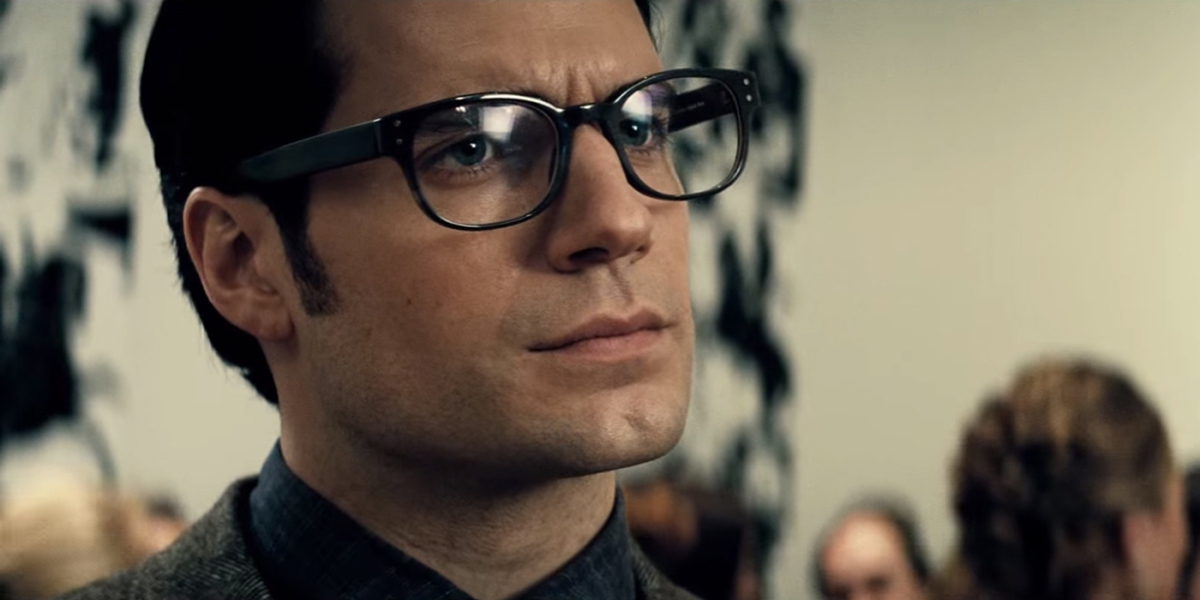 Official and unofficial cross-overs between DC and Marvel occur frequently. Clark Kent exists in the Marvel Universe, although not as his super-powered self. In Marvel, he simply exists as a mild-mannered reporter who writes about super heroes rather than join the fray himself.
Official and unofficial cross-overs between DC and Marvel occur frequently. Clark Kent exists in the Marvel Universe, although not as his super-powered self. In Marvel, he simply exists as a mild-mannered reporter who writes about super heroes rather than join the fray himself.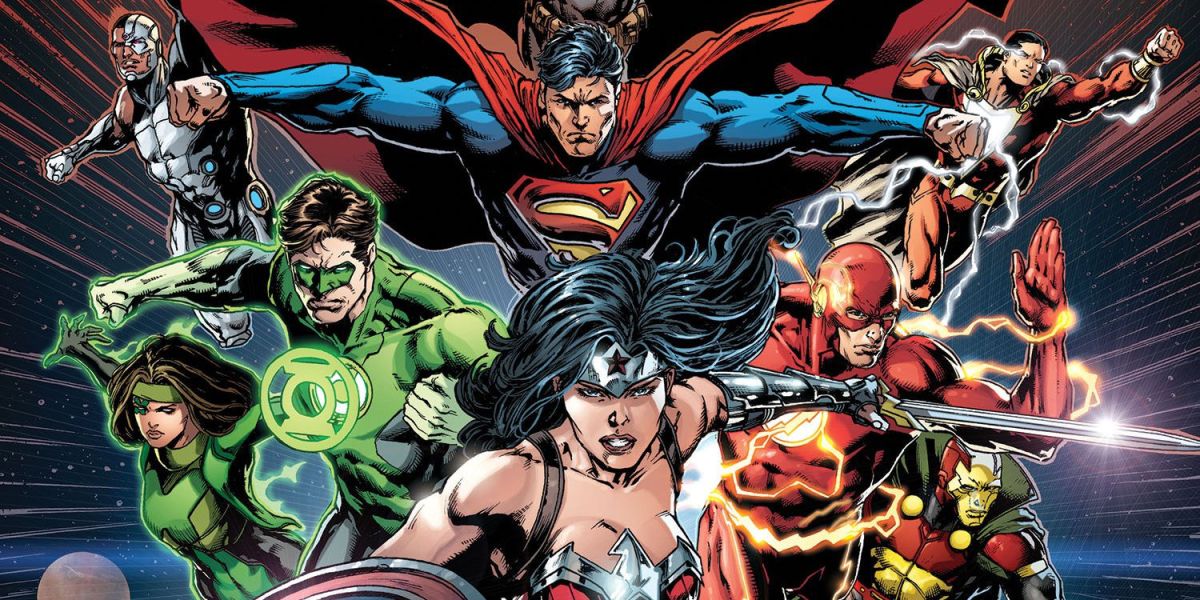 In 1984, Marvel dominated the comic book market and DC was struggling to make a profit. According to Jim Shooter, one of Marvel’s most controversial editors, they missed out on a chance to own some of the biggest names in the DC line-up because Jim Galton, Marvel’s President at the time, rejected DC’s offer to buy Superman, Wonder Woman, Batman, Green Lantern, and other heroes. Allegedly, in Galton’s opinion, DC must not have been doing well with sales because, “those characters must not be any good.”
In 1984, Marvel dominated the comic book market and DC was struggling to make a profit. According to Jim Shooter, one of Marvel’s most controversial editors, they missed out on a chance to own some of the biggest names in the DC line-up because Jim Galton, Marvel’s President at the time, rejected DC’s offer to buy Superman, Wonder Woman, Batman, Green Lantern, and other heroes. Allegedly, in Galton’s opinion, DC must not have been doing well with sales because, “those characters must not be any good.”